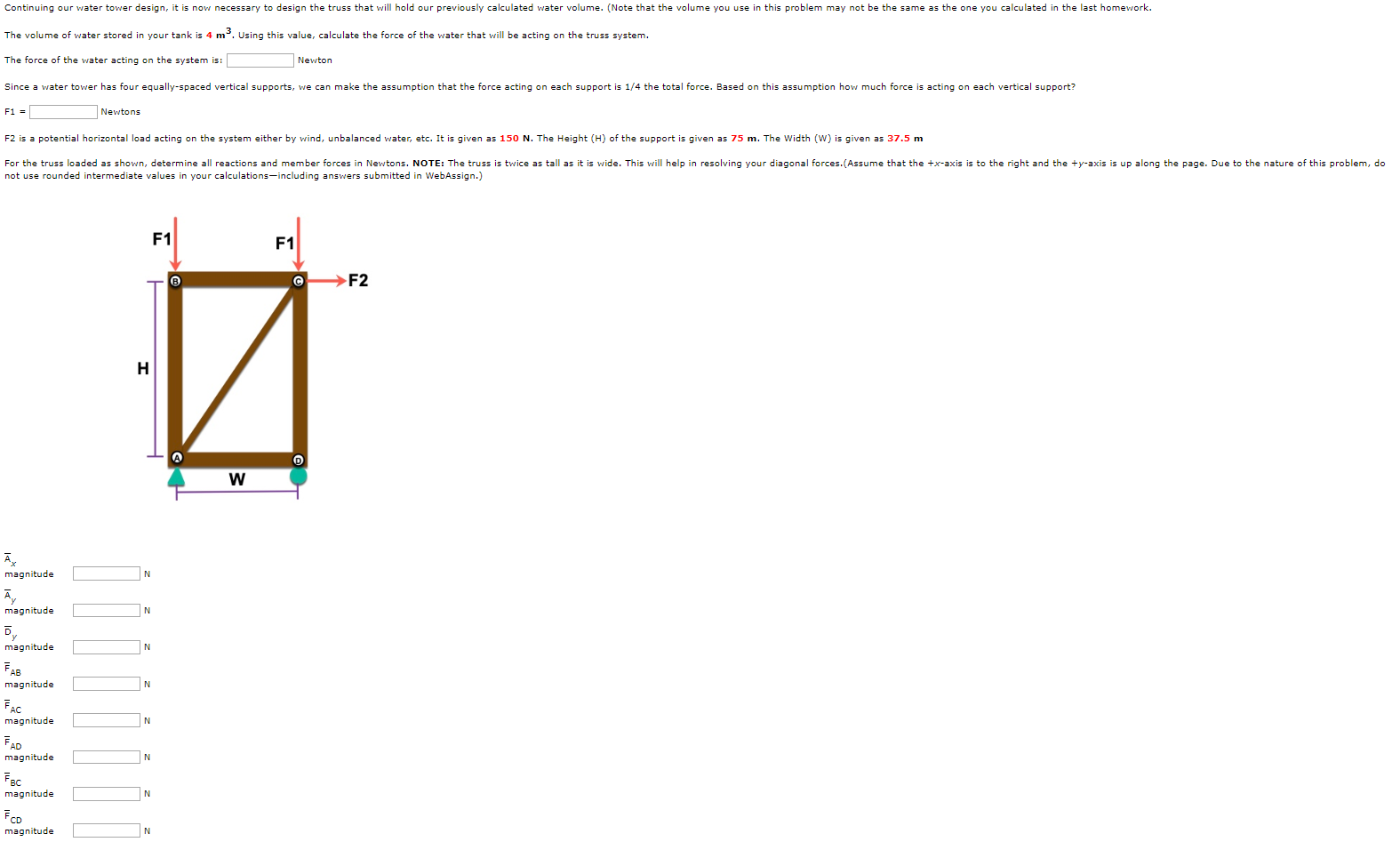Continuing our water tower design, it is now necessary to design the truss that will hold our previously calculated water volume. (Note that the volume you use in this problem may not be the same as the one you calculated in the last homework. The volume of water stored in your tank is 4 m. Using this value, calculate the force of the water that will be acting on the truss system. The force of the water acting on the system is: Newton Since a water tower has four equally-spaced vertical supports, we can make the assumption that the force acting on each support is 1/4 the total force. Based on this assumption how much force is acting on each vertical support? F1 = Newtons F2 is a potential horizontal load acting on the system either by wind, unbalanced water, etc. It is given as 150 N. The Height (H) of the support is given as 75 m. The Width (W) is given as 37.5 m For the truss loaded as shown, determine all reactions and member forces in Newtons. NOTE: The truss is twice as tall as it is wide. This will help in resolving your diagonal forces.(Assume that the +x-axis is to the right and the +y-axis is up along the page. Due to the nature of this problem, do not use rounded intermediate values in your calculations-including answers submitted in WebAssign.) F1 F1 →F2 magnitude Ā, magnitude magnitude FAB magnitude FAC magnitude FAD magnitude FBc magnitude Fco magnitude
Continuing our water tower design, it is now necessary to design the truss that will hold our previously calculated water volume. (Note that the volume you use in this problem may not be the same as the one you calculated in the last homework. The volume of water stored in your tank is 4 m. Using this value, calculate the force of the water that will be acting on the truss system. The force of the water acting on the system is: Newton Since a water tower has four equally-spaced vertical supports, we can make the assumption that the force acting on each support is 1/4 the total force. Based on this assumption how much force is acting on each vertical support? F1 = Newtons F2 is a potential horizontal load acting on the system either by wind, unbalanced water, etc. It is given as 150 N. The Height (H) of the support is given as 75 m. The Width (W) is given as 37.5 m For the truss loaded as shown, determine all reactions and member forces in Newtons. NOTE: The truss is twice as tall as it is wide. This will help in resolving your diagonal forces.(Assume that the +x-axis is to the right and the +y-axis is up along the page. Due to the nature of this problem, do not use rounded intermediate values in your calculations-including answers submitted in WebAssign.) F1 F1 →F2 magnitude Ā, magnitude magnitude FAB magnitude FAC magnitude FAD magnitude FBc magnitude Fco magnitude
Chapter2: Loads On Structures
Section: Chapter Questions
Problem 1P
Related questions
Question
100%
Neep help with this problem

Transcribed Image Text:Continuing our water tower design, it is now necessary to design the truss that will hold our previously calculated water volume. (Note that the volume you use in this problem may not be the same as the one you calculated in the last homework.
The volume of water stored in your tank is 4 m. Using this value, calculate the force of the water that will be acting on the truss system.
The force of the water acting on the system is:
Newton
Since a water tower has four equally-spaced vertical supports, we can make the assumption that the force acting on each support is 1/4 the total force. Based on this assumption how much force is acting on each vertical support?
F1 =
Newtons
F2 is a potential horizontal load acting on the system either by wind, unbalanced water, etc. It is given as 150 N. The Height (H) of the support is given as 75 m. The Width (W) is given as 37.5 m
For the truss loaded as shown, determine all reactions and member forces in Newtons. NOTE: The truss is twice as tall as it is wide. This will help in resolving your diagonal forces.(Assume that the +x-axis is to the right and the +y-axis is up along the page. Due to the nature of this problem, do
not use rounded intermediate values in your calculations-including answers submitted in WebAssign.)
F1
F1
→F2
magnitude
Ā,
magnitude
magnitude
FAB
magnitude
FAC
magnitude
FAD
magnitude
FBc
magnitude
Fco
magnitude
Expert Solution
This question has been solved!
Explore an expertly crafted, step-by-step solution for a thorough understanding of key concepts.
This is a popular solution!
Trending now
This is a popular solution!
Step by step
Solved in 6 steps with 10 images

Knowledge Booster
Learn more about
Need a deep-dive on the concept behind this application? Look no further. Learn more about this topic, civil-engineering and related others by exploring similar questions and additional content below.Recommended textbooks for you


Structural Analysis (10th Edition)
Civil Engineering
ISBN:
9780134610672
Author:
Russell C. Hibbeler
Publisher:
PEARSON

Principles of Foundation Engineering (MindTap Cou…
Civil Engineering
ISBN:
9781337705028
Author:
Braja M. Das, Nagaratnam Sivakugan
Publisher:
Cengage Learning


Structural Analysis (10th Edition)
Civil Engineering
ISBN:
9780134610672
Author:
Russell C. Hibbeler
Publisher:
PEARSON

Principles of Foundation Engineering (MindTap Cou…
Civil Engineering
ISBN:
9781337705028
Author:
Braja M. Das, Nagaratnam Sivakugan
Publisher:
Cengage Learning

Fundamentals of Structural Analysis
Civil Engineering
ISBN:
9780073398006
Author:
Kenneth M. Leet Emeritus, Chia-Ming Uang, Joel Lanning
Publisher:
McGraw-Hill Education


Traffic and Highway Engineering
Civil Engineering
ISBN:
9781305156241
Author:
Garber, Nicholas J.
Publisher:
Cengage Learning